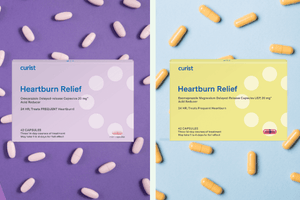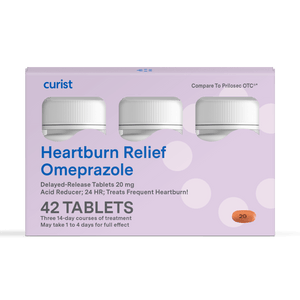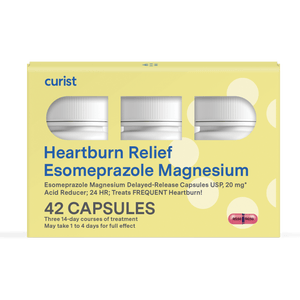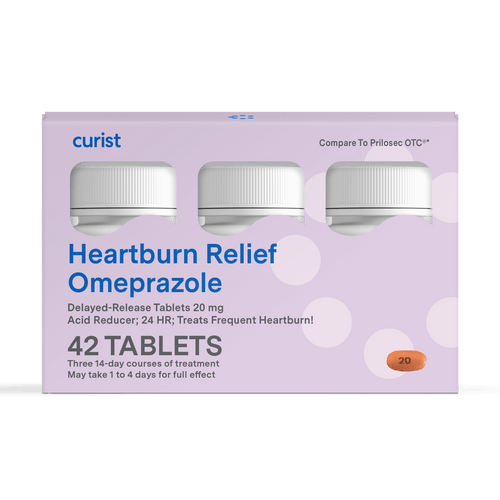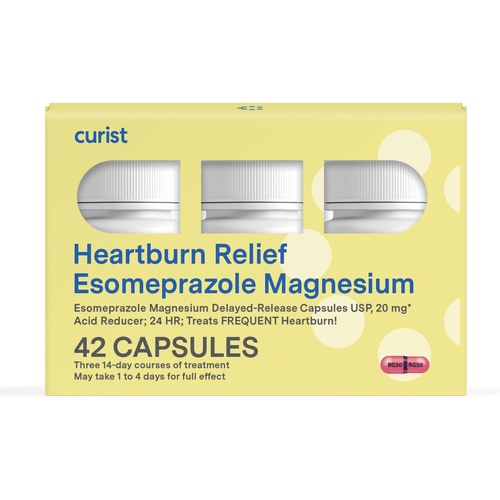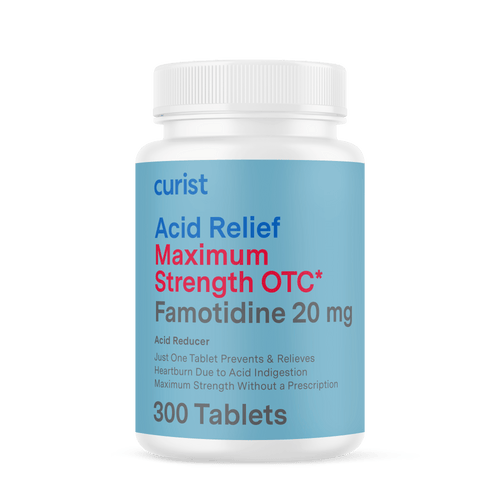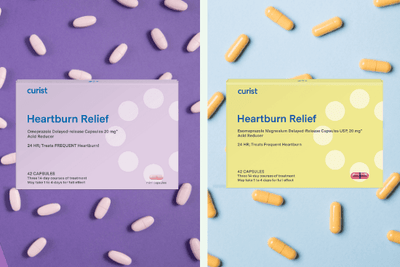Curist delivers over-the-counter medicines to your door at a fraction of the price of traditional brands. We hope everyone stays safe and healthy during this time.
To treat symptoms of heartburn and acid reflux, you have several over-the-counter (OTC) and prescription options to choose from. Medications for heartburn and acid reflux provide either fast acting or long-term relief from symptoms. In this article, we will be looking at three different classes of OTC medications indicated for treatment of heartburn and discuss their similarities and differences.
PPIs: What are Nexium and Prilosec?
Nexium (esomeprazole) and Prilosec (omeprazole) are part of a class of medications called proton pump inhibitors (PPIs). They work by reducing the amount of stomach acid made by glands in the lining of your stomach and are used to treat gastroesophageal reflux disease (GERD) or frequent heartburn that occurs 2 or more days per week. Because these medicines take time to work, PPIs like omeprazole and esomeprazole are not designed to treat infrequent heartburn or be an immediate relief for symptoms. To learn more about these medicines, please check out Curist’s articles:
To purchase, check out Curist for generic Nexium and generic Prilosec - the same strength active medicines at a fraction of the cost.
H2-Blocker: What is Pepcid (Famotidine)?
Pepcid (famotidine) is a histamine-2 receptor blocker. It works by reducing the amount of acid the stomach produces and is mainly used to treat and prevent ulcers in the stomach and intestines. Pepcid is also widely used to treat GERD and other conditions in which acid backs up from the stomach into the esophagus, causing heartburn symptoms.
To purchase Pepcid, check out Amazon for Pepcid.
Antacids: What is Tums (Calcium Carbonate)?
Tums (calcium carbonate) is an antacid. It provides fast relief by immediately neutralizing the heartburn-causing acid in your esophagus and stomach on contact. Tums is mainly used to relieve heartburn, sour stomach, acid indigestion, and upset stomach associated with these symptoms.
To purchase Tums, check out Amazon for Tums.
Are Pepcid, Nexium, Prilosec, and Tums the Same Thing?
No. While they all can help treat acid reflux, they work differently and therefore have different use cases. Pepcid and Nexium/Prilosec belong to two different drug classes. Pepcid is an H2-blocker and Nexium/Prilosec are PPIs, and though they both decrease stomach acid, they work in different ways in your body. Both classes are used to treat and prevent recurrence of stomach and duodenal ulcers. Pepcid is mainly useful in relieving mild, infrequent heartburn (less than 2 episodes per week) while Nexium/Prilosec is useful in managing frequent heartburn that occurs 2 or more days a week.
Tums, on the other hand, belongs to a separate drug class. It is an antacid. It goes to work in seconds to start neutralizing gastric acid in the esophagus, where the pain of heartburn starts. It keeps working as it dissolves, going to work fast to relieve the pain of heartburn. Because of its rapid mechanism of action, Tums is most appropriate for mild, infrequent heartburn (less than 2 episodes per week) and is not effective alone for moderate heartburn symptoms (at least once per week).
To purchase, check out Curist for generic Nexium and generic Prilosec - the same strength active medicines at a fraction of the cost.
What is the Difference: Pepcid vs Nexium vs Prilosec vs Tums?
Tums, Pepcid and Nexium/Prilosec are all considered effective medications for the treatment of heartburn and acid reflux, however, they differ in how they work and how they are used.
Prilosec vs Nexium vs Pepcid vs Tums: Frequent vs Infrequent Heartburn
As an antacid, Tums can be taken up to 4 to 5 times daily as needed for 14 days. Always take your antacid with food! This allows you up to three hours of relief. When ingested on an empty stomach, the antacid leaves your stomach too quickly and can only neutralize acid for 30 to 60 minutes. It is also important to consult your doctor or pharmacist prior to taking an antacid if you are on other medications to prevent interactions. Individuals with kidney or liver problems should never begin the use of antacids without speaking with their physician in order to avoid drug build-up.
As an H2-blocker, Pepcid can be taken up to twice daily as needed for 14 days. If you feel the need to use it for more than 14 days, make sure to consult your doctor first since long-term use of H2-blocker can suggest ineffective therapy. Pepcid typically starts relieving heartburn symptoms in just 15-30 minutes and can control acid for up to 12 hours. It can also be taken 30 minutes to 1 hour before a meal to prevent a heartburn episode. It is typically used for infrequent and mild to mid heartburn.
On the other hand, PPIs, like Nexium and Prilosec, are only intended to treat frequent heartburn and not intended for immediate relief. PPIs should be taken on an empty stomach about 30 minutes to 1 hour before you eat breakfast, once daily for 14 days. It can take 1-4 days for full effect but some people get complete symptom relief within 24 hours. This course of treatment can also be repeated up to three times per year (every four months) as needed.
To purchase, check out Curist for generic Nexium and generic Prilosec - the same strength active medicines at a fraction of the cost.
Nexium vs Prilosec vs Pepcid vs Tums: Side Effects
Nexium, Prilosec, Pepcid and Tums are all considered well tolerated medications. Most people do not experience side effects from taking them, but it is possible to experience constipation or diarrhea, nausea, vomiting, headaches, rash or dizziness in some cases. If they occur, the side effects are similar among Prilosec vs Nexium vs Pepcid vs Tums.
Which Works Better for Heartburn: Prilosec, Nexium,Pepcid, or Tums?
Both PPIs (Nexium, Prilosec) and H2-blockers (Pepcid) work by blocking and reducing the amount of stomach acid. However, randomized, controlled trials have shown that PPIs (Nexium and Prilosec) are more effective in treating GERD than H2-blockers. PPIs are considered stronger and faster in decreasing stomach acid production compared to H2 blockers. No significant differences were found between the PPIs that were studied, which included Nexium (esomeprazole) and Prilosec (omeprazole).
H2-blockers were found to specifically decrease the acid released in the evening which is a common contributor to peptic ulcers. This is the reason why H2-blockers are typically used to treat people who have ulcers or who are at risk for getting them, while PPIs are more often prescribed for people who have GERD or frequent heartburns.
Antacids (Tums) are great for providing fast, short term heartburn relief. It starts working in seconds and is an effective, first line medication for occasional and infrequent heartburn. However, because of its rapid mechanism of action, symptom relief does not last all day. Most people take an H2-blocker like Pepcid in combination with Tums to provide the quicker onset of action and longer lasting symptom relief.
To purchase, check out Curist for generic Nexium and generic Prilosec - the same strength active medicines at a fraction of the cost.
Can I Take Nexium, Prilosec, and Pepcid Together?
No, Nexium, Prilosec, and Pepcid should not be taken together. Scientists and Clinicians do not recommend taking both a PPI and an H2-blocker at the same time as they have overlapping mechanisms of actions despite working at different stages of production. When used together, it could ultimately lead to extensive acid suppression and decrease the absorption of certain nutrients (e.g. vitamin B12, iron and calcium) which are dependent on an acidic environment to be effectively absorbed in the stomach. Combination therapy may also increase the risk of hip fractures and gastrointestinal infections.
Can I Take Nexium, Prilosec, and Tums Together?
Yes, antacids like Tums may be taken with either Nexium or Prilosec to provide prompt heartburn relief. For example, if you experience heartburn symptoms while taking PPI, you may take an antacid to relieve it. However, keep in mind that there needs to be a gap of 2 hours between taking an antacid and a PPI to avoid drug interactions.
Can I Take Pepcid and Tums Together?
Yes, it is safe to take both the antacid (Tums) and the H2-blocker (Pepcid) at the same time for quicker heartburn relief. However, you should consult with your healthcare provider first prior to taking these medications together.
If you want to learn more about heartburn and various relief options, check out Curist’s other articles about heartburn:
- Omeprazole vs. Esomeprazole: Which Heartburn Medicine is Better?
- Nexium vs. Prilosec: Which Heartburn Medicine is Better?
- Tips to Relieve Heartburn at Night
- Food & Diet Tips to Reduce Heartburn
- Tips to Prevent Acid Reflux & Heartburn
Where Can I Buy Nexium, Prilosec, Pepcid, and Tums?
The over-the-counter versions of Nexium, Prilosec, Pepcid, and Tums are available in local pharmacies as well as stores online, and do not need a doctor’s prescription. To purchase, try:
For a less expensive option, at Curist, we develop FDA-approved equivalents to big brands in order to provide the same medicine relief but at a fraction of the price of the brands. Curist products are sold online and shipped directly to your door. To learn more:
- Curist Omeprazole (compare to Prilosec) is available as a capsule and tablet
- Curist Esomeprazole (compare to Nexium) is available here

